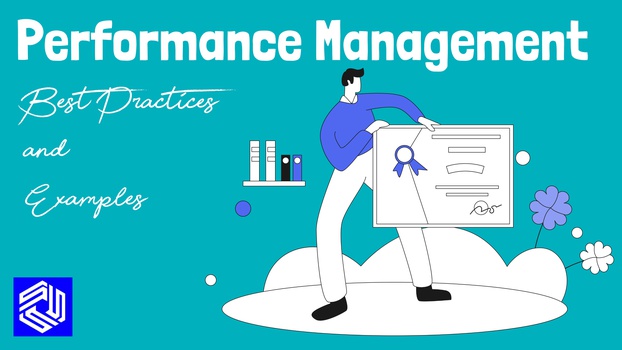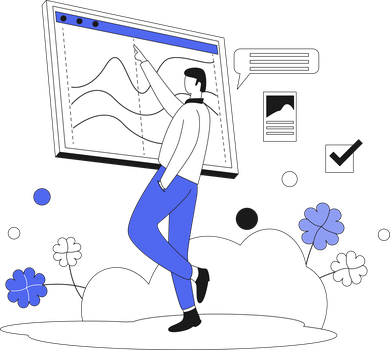Performance Management: Best Practices and Examples
In this blog we are going to be discussing performance management: best practices and examples. We will go over what performance management is, some best practices for performance management, and some examples of effective performance management.

What is Performance Management?
Performance management is the process of setting goals and expectations for employees, and then tracking and measuring their progress towards those goals. This process can be used to improve individual and team performance, and to identify areas where employees need more development or training.

Performance management is not just about setting goals and measuring progress. It is also about giving employees feedback on their performance, and providing them with the resources and support they need to improve.
Why is performance management important?
Performance management is important because it helps ensure that employees are meeting their job expectations and contributing to the overall success of the organization.
Additionally, performance management can help identify areas where employees need improvement and identify strategies to improve employee productivity.
The purpose and goals in performance management
There are four key components to an effective performance management system: goal setting, performance feedback, performance coaching, and performance appraisal.
Goal setting is the first step in the performance management process. Organizations should set clear and achievable goals for employee performance. Goals should be aligned with the organization’s strategic objectives and be specific, measurable, achievable, relevant, and time-bound.

Performance feedback is the second step in the performance management process. Organizations should provide employees with regular feedback on their performance. Feedback should be specific, objective, and constructive. It should be delivered in a timely manner and be based on observable behavior.
Performance coaching is the third step in the performance management process. Organizations should provide employees with the support they need to meet their performance goals. This may include training, mentoring, and guidance.
Performance appraisal is the fourth and final step in the performance management process. Organizations should appraise employee performance on a regular basis. Appraisals should be objective and based on a variety of factors, including goal achievement, performance feedback, and coaching.
Best Practices for Performance Management system
There are a few best practices that can help you get the most out of performance management:
1. Set clear and achievable goals.
2. Communicate those goals to employees.
3. Measure progress regularly.
4. Give employees feedback on their progress.
5. Provide employees with the resources and support they need to improve.
6. Be flexible and willing to adjust goals as needed.
7. Celebrate successes and learn from failures.
Performance Management Process Step 1 - Set clear and achievable goals
Performance management best practices include setting cleat and achievable goals, this means having a specific and measurable outcome that an employee is working to achieve. This could be something like increasing sales by 10% in the next quarter or reducing customer complaints by 50%. Having clear and achievable goals is important for a number of reasons.

Firstly, it gives employees a sense of purpose and something to focus on. Secondly, it allows managers to track progress and identify areas where employees may need additional support. And finally, it ensures that everyone is working towards the same objectives.
Some examples of clear and achievable goals could include:
- Increasing sales by 10% in the next quarter
- Reducing customer complaints by 50%
- Improving customer satisfaction scores by 3%
- Increasing web traffic by 20%
Setting clear and achievable goals is a best practice for performance management as it helps to ensure that everyone is working towards the same objectives and that progress can be tracked. If you have any questions about setting goals, or any other performance management best practices, please don't hesitate to get in touch.
Performance Management Process Step 2 - Communicating Goals to Employees
Organizations need to ensure that their employees are aware of the goals that they are trying to achieve. Good communication of goals is a best practice for performance management in an organization. It is important to communicate goals to employees for several reasons:
1. Employees need to know what the organization is trying to achieve in order to be able to align their own goals with those of the organization.
2. If employees are not aware of the goals, they may not be motivated to achieve them.
3. Good communication of goals can help to create a sense of ownership and responsibility among employees.
4. Employees need to be aware of the deadlines and milestones associated with the goals.

There are several ways in which organizations can communicate goals to employees:
1. Include goals in the employee handbook or other organizational documents.
2. Discuss goals during performance reviews.
3. Communicate goals through email, memos, or other written communication.
4. Hold team meetings to discuss goals.
5. Post goals in a visible location in the workplace.
Organizations should ensure that employees are aware of the goals that they are trying to achieve. Good communication of goals is a best practice for performance management in an organization.
Performance Management Process Step 3 - Measure Progress Regularly
It is a best practice to measure progress regularly in performance management in order to provide employees with timely feedback and identify areas in need of improvement. Measuring goals regularly also allows companies to track progress towards organizational objectives and ensure that resources are being used effectively.
There are a number of software tools that companies can use to measure goals regularly. For example, performance management software can be used to track individual and team goals, as well as progress towards company-wide objectives. This type of software can also be used to generate reports that can be used to identify areas of improvement.

Skhokho Human Resource Management App (HRMS) is ideal for recording, measuring and tracking performance management goals. Skhokho HRMS is integrated internally with Skhokho OKRs Application, allowing you to use Objectives and Key Results in your performance management cycles. Let us discuss more performance management software.
Key features of effective performance management software
There are a few key features that make up an effective performance management software. The software should help you collect and track employee data, give you the ability to set goals and objectives, and help you measure and assess employee performance.
An effective performance management software will help you collect and track employee data. This data can include things like attendance, productivity, and quality of work. This data can be used to identify trends and problem areas.
The software should also give you the ability to set goals and objectives. This can help you focus your team on the most important tasks. You can also use the software to measure progress towards these goals.

Finally, the software should help you measure and assess employee performance. This can be done through things like performance reviews and 360-degree feedback. This data can help you identify areas where employees need improvement and praise them for their successes.
Performance management software that includes OKRs is a great choice for organisations. OKRs can help you set and track progress towards specific goals. They can also help you measure and assess employee performance. Combined, these two features can help you create a best practice performance management system.
Performance Management Process Step 4 - Give employees feedback on their progress
Giving employees feedback on their progress is a best practice for performance management in an organisation. Why is giving employees feedback on their progress important.
Giving employees feedback on their progress is important for a number of reasons. It allows employees to see how they are doing and where they need to improve. It also allows companies to identify issues early and address them before they become bigger problems. Additionally, feedback can help motivate employees to do their best and improve their performance.
There are a few different ways that companies can give employees feedback on their progress. One way is to have regular check-ins with employees. This can be done in person, over the phone, or via email. During these check-ins, managers can ask employees how they are doing and give them feedback on their recent performance.
Another way to give feedback is to provide employees with written performance reviews. These reviews can be done periodically (monthly, quarterly, etc.) and can be used to give employees an overview of their performance. Additionally, companies can use performance management software to give employees feedback. This type of software can be used to track employees’ progress and give them real-time feedback.
Giving employees feedback on their progress is a best practice for performance management in an organisation. It is important for a number of reasons and there are a few different ways that companies can give employees feedback. By implementing these best practices, companies can improve their performance management processes.
Performance Management Process Step 5 - Provide employees with the resources and support they need to improve
One of the best ways to develop employees is to provide them with the resources and support they need to improve. This means giving them access to training and development opportunities, as well as providing them with feedback and coaching so that they can learn and grow in their roles.
Giving employees the resources and support they need to improve is important for several reasons. First, it helps to ensure that employees are able to do their best work and meet the demands of their roles. Second, it helps to retain employees and keep them motivated in their jobs. And third, it helps to create a culture of learning and development within the organisation.

There are many ways that companies can provide employees with the resources and support they need to improve. Some examples include offering training and development opportunities, providing feedback and coaching, and investing in employee development programs.
Giving employees the resources and support they need to improve is a best practice for performance management because it helps to ensure that employees are able to do their best work, it helps to retain employees, and it helps to create a culture of learning and development.
Performance Management Process Step 6 - Be flexible and willing to adjust goals as needed
Organisations need to be flexible and willing to adjust performance goals as needed in order to ensure that employees are motivated and remain engaged in their work. Being flexible and willing to adjust goals as needed is important because it allows organisations to respond to changes in the business environment and to the individual needs of employees.
Some examples of how companies can be more flexible and willing to adjust performance goals as needed include:
- Allowing employees to have a say in setting their own performance goals
- Encouraging employees to provide feedback on their performance goals
- Conducting regular reviews of employees' performance goals
- Modifying employees' performance goals in response to changes in the business environment
By being flexible and willing to adjust performance goals as needed, organisations can ensure that employees are motivated and engaged in their work.
Performance Management Process Step 7 - Celebrate successes and learn from failures
It's important to celebrate successes and learn from failures in performance management in order to improve and excel in your role. Celebrating successes allows you to share your accomplishments with your team and learn from your mistakes. It also allows you to set an example for others to follow.
Learning from failures is just as important as celebrating successes. By understanding what went wrong, you can avoid making the same mistake again. It's also important to share your learnings with your team so that they can benefit from your experience.

Here are some ways companies can celebrate successes and learn from failures:
-Share successes and failures openly with the team.
-Encourage employees to share their successes and failures.
-Set an example by sharing your own successes and failures.
-Encourage employees to learn from their failures.
-Provide resources to help employees learn from their failures.
Examples of Effective Performance management systems
There are a number of companies that have implemented an effective performance management systems. Here are a few examples:
1. Google Performance Management System:
Google has a performance management system that is focused on setting and measuring goals. They use a tool called OKRs (Objectives and Key Results) to help employees track their progress.
Skhokho Performance Management has built on OKRs to help you create, set and track goals on a regular basis. OKR reporting is detailed enough to form the basis of an effective performance management system. Give Skhokho OKRs a try with a free 14 day trial here:
https://skhokho.io/authentication/register
2. Amazon Performance Management System:
Amazon uses a system called Pivot Tables to help managers track employee performance. Pivot Tables allows managers to see which employees are meeting their goals, and which ones are falling behind.
3. Zappos Performance Management System:
Zappos has a system called 360-degree feedback, which allows employees to receive feedback from their peers, managers, and customers. This feedback is used to help employees improve their performance.
4. LinkedIn Performance Management System:
LinkedIn uses a tool called Lighthouse to help managers track employee performance. Lighthouse allows managers to see which employees are meeting their goals, and which ones are falling behind.
5. Facebook Performance Management Systems:
Facebook has a system called APEX (Achievement, Potential, Engagement, and eXperience) to help managers track employee performance. APEX allows managers to see which employees are meeting their goals, and which ones are falling behind.









